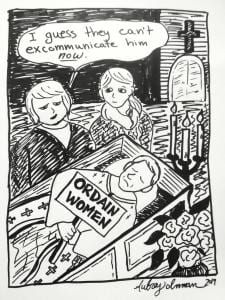“What I came to, is that as Catholic priest, I was in a profession that discriminated against women.” – Roy Bourgeois
It has been seven years since Roy Bourgeois was laicized and excommunicated from the Catholic Church for advocating for women’s equality.
Ordained a priest in 1972, Roy’s remarkable journey includes a Nobel Peace Prize and Oscar nomination, serving in the US Navy in Vietnam, living as a missionary in Bolivia, serving several prison sentences for protesting, and becoming a founder of the School of the Americas (SOA) Watch, a broadly-supported movement to end U.S. militarism in Latin America. Along the way, he made friends with the women who would open his heart to systems of injustice in which he was embedded: sexism and misogyny in the Catholic Church.
This February, as Pope Francis and the Bishops will meet to discuss the ongoing sex abuse crisis, Roy’s experience gives us a window into a secretive clerical culture that seems unlikely to reform itself. Roy was excommunicated from the Catholic Church and laicized from the Maryknoll Order of priests because he followed his conscience, choosing to listen to people of faith rather than blindly follow tradition – an exclusionary act, which Roy observed, that corresponds to the Church’s history of institutional racism.
Roy turned 81 this January and his timeless grin continues to radiate out of his bright blue eyes. He chose to live in solidarity with his friends, and a decision like that, despite the consequences, brings peace. Throughout his life, Roy allowed his power to be challenged, and his heart to remain open. His story is compelling because it shows that important paradigm shifts can occur at any age if we allow ourselves to be open. Sadly, his story also shows how clergy will turn on their own, if their power is threatened.
I first met Roy in 2015 during the last SOA Watch convergence held at Ft. Benning in Columbus, Georgia. If you are not familiar with the movement, I would recommend watching this Empire Files episode for background, in which Roy is featured. At the time, I knew who he was but I did not fully understand his impact until I read his remarkable biography Disturbing the Peace. The following year, I attended the first SOA Watch Encuentro in Nogales, AZ/Mexico. We shared margaritas one evening, which led to a letter-writing friendship. I’d long wanted to hear more of Roy’s personal journey and he agreed to a phone interview this past December. This article is based on that conversation.
For many Catholics, 2018 was a year of reckoning. I personally have come to a new spiritual place in recent months and I frequently thought of Roy’s journey during my reflections. What I wanted to learn from Roy was this: How did his encounter with women called to be Catholic priests change his worldview? How did it feel to be excommunicated and cut off from the ministry to which he gave his life? What does it mean to be an outsider in the Church?
All quotes below are attributed to Roy, from two phone conversations in December 2018.
Paradigm shift
“Something happened after many years of organizing for SOA Watch. I started meeting women in my talks around the country who would say:
‘You’re a Catholic priest, I’m a devout Catholic woman—and I too am called by God to be a priest, like you are.’ And I remember the first woman I’d met, being somewhat surprised. Not threatened by her, but let’s just say it kept me awake at night. First one woman, then two, then another and another and it really forced me to think about what they were saying. They ask—’why is your call from God as a man to be a priest authentic, but my call by God as a woman to be a priest not authentic?’”
Rather than explain the injustice away with the usual talking points, Roy considered the words of his friends.
“It didn’t take that long to realize that what these women were saying was so true. And it forced me to reflect on my six years in the seminary when I was being trained to be a priest. We started using words there, which was the beginning of the, shall we say, clericalism. The root of the problem is sexism, it’s discrimination. We were really brainwashed from an early age not to question the Church’s teachings.”
“In the seminary we learned that we were the consecrated ones. We, the men, were the ones called by God with a special task. We were called to be priests. And what we were doing, women couldn’t do. In subtle ways we were seduced by thinking we were very special, chosen by God. Looking back what I realized is that we were getting a taste of power. We were experiencing that pedestal thing. We became the focus, and somehow our profession is different from others. And how people start treating us differently, even our friends and family, that’s when it really sets in. The addiction to power.”
As women told Roy their stories, he began to think about his childhood. He remembered how racism was reinforced through religious experiences from an early age. Roy grew up in Luchter, Louisiana during segregation. He attended a Catholic Church where black parishioners were only allowed to sit in the last five pews of mass.
“And not one person, not one teacher or priest said it was racism. They said ‘this is our tradition.’ We justified our segregated churches and schools by saying it was our tradition, and we are separate but equal. So I started reflecting on our priesthood, our all-male priesthood. It’s the same thing. The same tactics. We say ‘women can’t be ordained, it’s our tradition.’ The Church is using theology to justify our sexism just as we did our racism.”
(It should be noted that racism in the American Catholic Church is a major topic of injustice in itself. This discussion of ‘tradition’ does not intend to equate the experiences of black Catholics with sexism experienced by women.)
As Roy’s eyes opened to the exclusion of women in the Church, he began incorporating this injustice into his talks about SOA Watch.
“I’d end my talks discussing this injustice closer to home in my Church, as a Catholic Priest. What I would say, is:
What we have here is this grave injustice against women, and against God. What we have here is a sin, the sin of sexism.
“So wherever I spoke I brought this out, and then I started getting calls from Maryknoll. I was being reported as speaking against Church teaching. I was told to be quiet—focus on SOA Watch. I said, ‘Nope, not possible.’”
A break-away Vatican Radio interview
“I started speaking out more and then a turning point came. I was invited to Rome to speak about the SOA Watch at a conference with 300 or so priests and women religious. So I went there and spoke, and afterward I was so disappointed in myself because I didn’t mention women’s ordination, maybe because I was afraid. It kept me awake at night. I felt like a coward. And I felt like I betrayed friends. I thought what am I becoming? I thought I missed an opportunity that will never come again.
“But then, the next day, I received an invitation to speak on Vatican Radio, a 15-minute live interview, translated into several languages, and I thought wow! When I woke up that morning, I knew what I had to do, so I went into St. Peter’s Basilica to pray and get some courage. So for 12-13 minutes, the focus of the interview was SOA Watch, and then I said ‘there is something else I have to talk about as a Catholic priest. We’ve been talking about injustice in US foreign policy and I want to talk about an injustice in the Church—this injustice is against women. Women like men are called to be priests. And saying that only men can be priests is wrong.’ Then the station manager came in with about a minute left and cut me off, and started playing Gregorian music. I’ll never forget that. I felt so good.
“After the interview, the women who worked in the radio station invited me for a cup of coffee and they said they’d never heard anybody talk about it before. They said they traveled with the Pope often and that ‘certain topics are off-limits.’ They were grateful to hear someone talk about women’s equality.
“Of course, when I returned there was a call waiting from the Superior General at Maryknoll New York and they said ‘you better be careful, because what you were saying is really serious.’ And I said, ‘Okay, thanks for sharing,’ and I kept talking about it.”
Jesuits pull support for SOA Watch over women’s equality
It wasn’t just the Maryknolls who were uncomfortable with Roy’s open discussion about sexism in the Catholic Church. The Jesuits, who were an integral organizing power within the SOA Watch movement, expressed concern as well.
The Jesuits were highly involved in the SOA Watch movement from the beginning, to honor and bring justice to the Jesuits who were murdered at the hands of SOA graduates in El Salvador during the civil war in the 1980s. Dozens of Jesuit Universities and High Schools organized their Ignatian Family Teach-In during the same time as the SOA Watch Days of Action.
“We had 3000 students from Jesuit schools attending SOA Watch every year, along with the presidents and professors of their Universities. The Jesuits would invite me to address their students, give them updates about how the movement was doing and thank them. But when I started coming out speaking publicly about women priests I got a call. They asked me not to bring up women’s ordination. And, I said as a speaker, I’ve never been told what I can and cannot say, so I said maybe you should disinvite me. And they said ‘No, the students would be disappointed, but just think about it.’
“It was a 15-minute speech, and I mostly spoke about the SOA Watch. And then in the last few minutes I said we need to focus on another injustice close to home. You’re Catholics, and I just want to let you know that as a Catholic priest there is another injustice we need to address. I am calling for the ordination of women and as a result I’m being told to keep silent, and I cannot do that. I said, there will not be justice in our Church until women can be ordained.
“The students all stood up and clapped when I called for the ordination of women – because a lot of these students support women’s ordination too.”
The next year, Jesuit Universities pulled their support from SOA Watch, and started planning their Ignatian Family Teach-In in a different location.
To bring insult to injury, a familiar talking point among supposedly social justice-minded Catholics was to blame Roy’s support of women over the diminished support of SOA Watch.
“Some people said I was hurting the SOA Watch movement by discussing women’s ordination.”
Supporting women’s ordination from their coffins
Roy tried many times to convince his Maryknoll friends and other priest friends to sign letters publicly supporting women’s ordination. He was convinced that if 20, 30, 50 priests banded together they couldn’t all be kicked out.
“Not one would sign.”
However, he did eventually convince three priest friends to write into their legal wills that upon their death, they would wear “Ordain Women” pins on their cassocks while laying in their coffins.
“They can’t excommunicate them when they’re dead!”
(I commissioned my friend, artist Aubrey Inman, to illustrate this absurd scene, above.)
Friend’s ordination leads to excommunication
Roy believed in the sacredness of women’s ordination, and when he was invited by his friend, Janis Sevre-Duszynska, to attend her ordination, he was happy to participate. There are about 300 women worldwide who have been ordained as priests, many of them in the US. If you haven’t been to one of their services, don’t knock it until you try it. I’ve been to a few, and have never experienced anything that felt closer to what Jesus called his followers to partake in. They are beautiful communal ceremonies with feminine warmth and love, without rank or pomp.
Nevertheless, a woman who seeks to be ordained as a Catholic priest suffers excommunication, as does anyone who participates in her ordination.
“After I participated in the ordination of Janis, that is when it got serious. When I returned from Kentucky I was summoned to Maryknoll headquarters for a meeting. They said they had to send the Vatican a report on me.”
During the meeting, Roy said that he repeatedly asked questions to the Maryknoll Priests and Canon Lawyer who were present. He said they refused to discuss women’s equality, saying:
“Pope John Paul II said we cannot discuss the issue. It’s closed.”
“I said, ‘We’re grown men. And the last time I was told I couldn’t talk about something I was a little kid.’ I said, ‘What happened to reason? What happened to being an adult?’ And there was silence. And I said, ‘I have to tell you this issue of women priests is being discussed throughout our church, and they are coming. This discussion is going on with you or without you.’”
Roy later noted that the average age of priests at Maryknoll is 79. Like many religious orders, their seminaries are closing. Half of the men who were in his seminary class have left to marry or pursue other careers. Across the country, Catholic parishes are closing, for lack of new vocations from men (among the myriad of other issues including rampant sex abuse). What Roy was saying was both a practicality and a reading of the sensus fidelium. He maintains that he has listened to the spirit speaking through faithful people. He has read the signs of the times.
So what are the bishops doing?
Excommunication and Laicization
“It didn’t take long to get the letter from the Vatican. The Congregation of the Doctrine of Faith said only men are the true teachers of faith and morals. The letter said that I had 30 days to recant the public support for the ordination of women or I would be expelled from the priesthood and Maryknoll. I took a week off. I thought about it seriously.
“I wrote back to the Vatican and said what you are asking of me is not possible, it goes against my conscience. You are asking me to lie, to say something I do not believe and you must realize that God did make women and men equal, and what we have here is a classic case of sexism and misogyny. They said I caused a grave scandal.
“I said when Catholics hear about grave scandal they don’t think about women’s ordination, they think about the predator priests and the bishops who covered up for them while they abused children for decades.”
So, the letter came from Pope Benedict, and Maryknoll supported his decision to laicize Roy.
“Really, I wept when I got the call from Maryknoll. I felt so disappointed in myself, that maybe if I had been more eloquent, if I had reasoned more with them they had understood. But my friends said, ‘No. There’s nothing you could have said.’
“And I did think I was preparing myself for this, but like many things we go through, I didn’t really understand the consequences. I didn’t realize how sad and how hurt and rejected I would feel because I’d been in the community for so many years. It was a community of long-time friends and we’d been through a lot together in Bolivia, in SOA Watch. And it was like family. But getting that letter, expelling me from Maryknoll and the priesthood was just harder than I’d ever anticipated. I had to deal with a lot of anger. I was so hurt and disappointed by long-term friends.”
Solidarity, healing, and hope
Roy said it took him several years to get over the anger of being rejected by his own. But he says that the grace of the experience has been a new understanding, and solidarity with people in our society who are rejected by their families and groups.
“I’ve felt that what I’ve been experiencing in the way of rejection of shame and hurt is but a glimpse of what millions and millions of people go through every day because of their gender, their race, their sexual orientation. So many people have gone through so much rejection. I couldn’t have come to that glimpse of understanding without crossing the line.”
Roy said after the Pennsylvania Grand Jury report in the summer of 2018, he experienced a turning point.
“For the first time I got to thinking, wow, I certainly would not want to be in this old boy’s club now. It’s such an embarrassment. I’m happy I was kicked out rather than stay in to justify my power and whatever.”
Roy continues to travel across the country and advocate for women’s ordination as well as for SOA Watch. He recently completed a week-long speaking tour in Upstate New York where he was greeted with people who, due to the sex abuse crisis, are opening their eyes to the many injustices in the Church. He said he has hope in the people who he continues to meet, as well as young people who are willing to question the Church’s teachings.
“Many young people that I meet now say they will only belong to organizations that treat their members as equals. That gives me hope.”
In 2019 there is a sense that the Church is at a turning point in history. Roy’s journey serves as a sign-post for the future. Why not speak from our hearts? Courage is contagious.
Sophie Vodvarka enjoys writing about creative living, particularly spirituality, art, travel, and current affairs. She has an affinity for gypsy music and lives joyfully in Chicago with her partner. She blogs at Straight into Oblivion, and can be found on Twitter @SophieVodvarka.
An earlier version of this essay used the terms “excommunication” and “laicization” interchangeably. Many thanks to the reader who drew our attention to this distinction.













